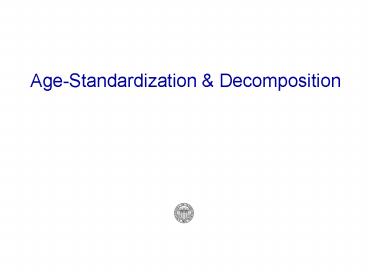AgeStandardization - PowerPoint PPT Presentation
1 / 26
Title:
AgeStandardization
Description:
CDR is a function of the mortality schedule AND the age distribution ... Age-Standardized CDR = ASCDR. Replacing the n,x notation with i: ... – PowerPoint PPT presentation
Number of Views:36
Avg rating:3.0/5.0
Title: AgeStandardization
1
Age-Standardization Decomposition
2
Period Age-Specific Death Rate
- Death Rate for ages x to xn during the period
spanning 0 to T
M is the death rate D is the number of deaths N
is the population
3
Lexis Diagram
4
Components of the Crude Death Rate
- Dropping the period notation
nCx is the proportion of the population between
ages x and xn
5
Standardization
- CDR is a function of the mortality schedule AND
the age distribution - Changes in either or both affect the level of the
CDR - When comparing CDRs, it is important to isolate
the source of the differences - Differences in age-specific mortality rates?
- Differences in age distributions?
- Age standardization holds the age structure
constant so that the only source of difference is
the mortality schedule - Same applies to any division of the population
that produces differing rates (or proportions)
6
Age-Standardized CDR ASCDR
- Replacing the n,x notation with i
The Age-Standardized Crude Death Rate is
Where Cs is a standard age distribution
7
Selection of a Standard
- There is no correct way to choose a standard
- As the covariance between the standard and the
schedule increases, so will the value of the
standardized rate - The average of the proportionate distributions
being compared is a good choice in general
Where there are N distributions indexed over x
8
Age Standardization CDR
- We want to compare the crude death rate from two
populations - P1 has lower child and higher old-age mortality
- P2 has higher child and lower old-age mortality
- P1s age distribution is almost constant,
comparatively unloaded on young ages and loaded
on old ages - P2s age distribution is loaded on younger ages
and unloaded on older ages
9
Example Mortality Schedules
10
Example Age Distributions
11
Calculation of Standardized CDRs
12
Comparison of CDRs
Crude Death Rate
13
Standardization Income
- We want to compare male and female average income
distributions for the working population - The proportionate measure is the job
category-specific average income, AIj, for the
period 0 to T
14
Job Category Standardized Average Income
- As with the CDR, AIj can be written as the
product of two components the job
category-specific average income and the
proportion of the population holding jobs of each
category
15
An Employment Distribution Effect - Chart
16
An Employment Distribution Effect
17
An Average Income Distribution Effect - Chart
18
An Average Income Distribution Effect
19
A Joint Effect - Chart
20
A Joint Effect
21
Decomposition
- Decomposition refers to a technique that
identifies the proportion of the difference
between two crude death rates that results from
the differences in the mortality schedules and
the differences in the age distributions - As with the standardization technique described
earlier, this is a general technique that can be
used with any crude proportion formed as the sum
of proportionate distribution and a proportional
measure
22
Components of Difference in Crude Rates
23
Derivation of Decomposition
24
Composition Rate Contributions to Difference
25
Decomposition Example CDR
26
Check Decomposition































